#BC designs basins
Note
as someone who. does not keep up with games pre-release, like, at all. what was below zero like before it was changed? i don't think i even heard about BZ until after it was released which is shocking considering how obsessed i am with the first game lmao
God so. It was actually pretty dang different. Jacksepticeye has a playlist where he played through the early access below zero builds. If you were unsatisfied with below zero (as i very much was), I greatly recommend looking up the playthroughs and checking them out cause the whole arc is sooo much better than what we ended up getting
for starters, robin's sister sam wasnt dead. Robin and her spoke to each other, as her sister was on a space station orbiting 4546B, and the main plot was about thwarting alterras meddling with the planet and keep the precursors and their tech from their knowledge, with robin as an actor on the surface doing stuff, and robins sister on the satellite using her admin job to keep alterra off of robins back. it was actually a pretty dope setup!
Another major difference is what pushed robin into the ocean, which was a huge avalanche destroying the base she was in. As in, robin was ACTUALLY stationed in the frozen zone working, when an avalanche destroys her base and forces her to go into the water to survive.
All of this was changed in the final cut to remove sam from the plot and having robin instead just crash land on 4546B to try to find her.
I think they also changed Maida's purpose a LOT because she was hinted at being more useful and it feels like, if the whole 'keeping alterra off your back' arc had remained, she would have had much more to do with it than she ended up having in the final cut. which was bossing you around to fetch a single thing and then not being relevant again
It just really feels like something went wrong and the story of the game is half baked at MOST (not to mention the design of the map but that's for another rant...) because like... when robin gets al-an in her head she is just so adamant on removing her and then SHE STAYS THAT WAY basically the whole game? al-an is nothing but a sweetheart to her and shes so fucking mean to him all the time i actually just didnt get it while i was playing. its so unnecessary, constantly cuts him off, shuts him up, etc etc. pretty much all the way until the end.
and then suddenly for the ending cutscene they are practically in love with zero warning. shes like oh my god i would follow you anywhere i would go anywhere with you. Bestie you hated his guts the whole 10 hour runtime of game what are you talking about................
It genuinely feels like something went wrong for sure.
And like, the alpha game pre-release was practically done!! The last major update they did to the early access was up until you create the body for al-an, which is literally the second to last thing you do for the story. You give him a body, and then immediately after that you can trigger the ending scene (at least in the final release, they might have had more planned after that in the original writing bu we will never know)
Which just made it so insanely jarring when you played the final release, which released over a year after that (i think), and the whole story arc was just. Gone. Replaced with what we got. I might be insane and the story got more and more replaced as early access went on, I am just going off of my memories of watching Jack's playthrough so take what I say with a grain of salt in terms of timeline accuracy, but the game was definitely changed beyond recognition from early access to final release as it went a complete and total rewrite more than halfway into production when they let go of their lead writer
#ask#anon#subnautica#i followed this game relatively closely as it was released bc yeah im a huge subnautica fan#the first game is absolutely one of my favorites of all time for sure#so seeing the second game flop so hard just made me upset. and some of the game design elements are actually atrocious too#that it had me completely tilted playing some parts of it too bc it got infuriating. the fuckin ice basin zones.... god damn.#anyway this is my rant. i should go rewatch jacks early access videos its been a while since i did that
37 notes
·
View notes
Text










Whistler, BC (No. 1)
Whistler is a resort municipality in Squamish-Lillooet Regional District, British Columbia. It is located in the southern Pacific Ranges of the Coast Mountains, approximately 125 km (78 mi) north of Vancouver and 36 km (22 mi) south of Pemberton. It has a permanent population of approximately 13,982 (2021), as well as a larger but rotating population of seasonal workers.
Over two million people visit Whistler annually, primarily for alpine skiing and snowboarding and, in the summer, mountain biking at Whistler Blackcomb. Its pedestrian village has won numerous design awards, and Whistler has been voted among the top destinations in North America by major ski magazines since the mid-1990s. During the 2010 Winter Olympics, Whistler hosted most of the alpine, Nordic, luge, skeleton, and bobsled events.
The Whistler Valley is located around the pass between the headwaters of the Green River and the upper-middle reaches of the Cheakamus. It is flanked by glaciated mountains on both sides; the Garibaldi Ranges on the side that contains the ski mountains, and a group of ranges with no collective name but that are part of the larger Pacific Ranges and are essentially fore-ranges of the Pemberton Icefield. Although there are a few other routes through the maze of mountains between the basin of the Lillooet River just east, the Cheakamus-Green divide is the lowest and most direct.
Source: Wikipedia
#The Three Watchmen by James Hart#travel#original photography#vacation#tourist attraction#landmark#landscape#clouds#nature#cityscape#flora#Canada#summer 2023#British Columbia#blue sky#countryside#snow#forest#tree#Whistler#woods#fir#pine#evening light#Coast Mountains#Pacific Ranges#small town#Olympic Rings#Olympic Plaza#architecture
2 notes
·
View notes
Text
ask dump... what is this. twelve?
something like that. topics this time include: weather, propaganda songs, catchphrases, living inside a mechanimal, black markets, centipede watch, martial arts, backpacks, paintball, and Rhinox

Cybertron is not a very wet planet, so there’s not actually a lot of precipitation in most places. when there is, it’s definitely water, although often acidic and impure. there’s permanent ice caps at the poles, and it can get cold enough to rain dry ice. wind and dust are more commonly tracked weather patterns than humidity, although high humidity and occasional heavy precipitation still occur, they’re just guided by the planetary weather department. floods are very common in the Rust Sea, since it’s a seasonal floodplain in an endorheic basin. flooding is actually a major problem everywhere else, even though it’s a very rare problem. soil isn’t really a thing, and most of Cybertron is bad at absorbing water, so flash floods can be huge until they find a crack or canyon or porous material to soak through. underground cities especially need to be designed with this in mind
standing out in the rain isn’t actually a big deal for most mecha! water is iffy when submersed in it, but not inherently dangerous. your car will be okay in the rain, but not driving into the ocean, yknow? the average person spending hours in a torrential downpour may end up with some water damage, but it’s not a big worry unless they’re particularly delicate. honestly more people are concerned with acidity rather than water damage! flightframes flying through storms or who live near the poles or higher mountains do have to contend with ice buildup, which is a concern because of wing shape and weight rather than wetness
Velocitron is a desert that sees little to no precipitation, although it isn’t so hot as to be unbearable in SNAP so folks do go out into the sunlight. Caminus has a lot more water and thus wetter weather, Devisiun is two dry planets, and Eukaris actually has proper oceans. Carcer is like a blend of Cybertron’s metals and Velocitron’s rocky desert

yknow i’ve been sitting on this one for awhile and i still don’t know! i’m not well versed in this area tbh. i imagine there are city-state and planetary anthems, historical ballads about the might of the Stratocracy, religious hymns edited to include functionist values as praise, and old folk tunes taken and repurposed as patriotic songs. and of course as their equal opposite there are workers’ songs, old miners chants and spacer shanties, complaints about the government put in a rhyme and a metaphor and hummed on the job, junker ditties traded as a game on the street, and soulful songs calling for the Primes or the Guiding Hand to come sweep away the evils of this world. and all the other types in this marvelous post

of COURSE they do, this is in the ANIME genre! the sort of general faction catchphrases are in this lil chart here, eg the Autobots with the classic “Roll out!” that Optimus says and “Peace by example!” summing up their ideology. i also tried to come up with snappy descriptions for these tech specs that aren’t exactly catchphrases but fall in that same general area. otherwise, i am going to sneak in as many quotes, references, Easter eggs, and Furmanisms as possible

(the post this is referring to)
definitely not very survivable. or, maybe survivable, technically, but not super livable or thriveable. they are animals, not vehicles, and they don’t really turn into vehicles either. so while maybe you could fit inside, idk, ballast tanks, or air sacs, or something, it’s going to be uncomfortable, because you are Inside The Internal Organs Of A Living Creature. you will also definitely be setting off a critical immune response in said living creature bc debris isn’t supposed to be inside there, or worse, parasites. because honestly that’s what you’d be, a parasite. if you want to live comfortably inside a living creature, you’ll have to dig up some fairytales and find a Titan

aafdja;slgheuorjlhfhd the way you phrased this, anon-- jwrgohjjf
there’s certainly organized crime rings, mobs and mafias, and black markets that do focus on the smuggling of contraband or goods or even people. Thunderhoof is definitely not involved with any of these shhhh thanks. Lockdown totally isn’t involved either, and Rum-Maj absolutely has no connections to the underground markets of junkers. actually this is a niche i have Shadow Striker filling but she is so far in the background as to be invisible in SNAP’s story
in general i mean a lot of black market stuff is more illegal than automatically evil? like yes outlawed goods and services could certainly be immoral but they could also just be illegal as a method of control, it will depend on the situation in question. technically mechanimal parts sold for consumption are black market items, which is completely ignored on Carcer. when Maccadam preps a mechanimal dish from Carcer for school lunch, he is absolutely dealing in black market trading. which, cmon, it’s Maccadam. he knows how to skirt the consequences
i think perhaps the biggest arguably “non evil” black market is every junker trader, vendor, and fence. they don’t have functions so they technically aren’t allowed to do any sort of business, but they do anyway, and the illegality automatically makes them the widest spread and most ubiquitous black market. and it’s all like, innocuous stuff to just barely scrape by. recycled stuff out of the trash, scraps and hastily repaired items, maybe some handmade doohickeys. they largely trade amongst one another and very low caste mecha so they don’t risk catching anyone’s attention. they’re doing this for survival and barebones enrichment, not high risk items and giant trades. patronizing a junker market is a good way to support them, theoretically, but if you aren’t already 100% proven ride or die best buddies with a junker, good luck ever finding a market. they are not risking their safety so some strangers can buy their trinkets, that’s how they get empurata’d or worse. the locations vary and the vendors vary and the everything varies all the time, so there’s no real constants i can describe, but perhaps the most wanted items junkers would trade for would be medical supplies, hygiene supplies, fresh energon, and upgrade stockpiles for the gutter children. a communal benefit rather than individual profit

yknow i haven’t really thought about it? i feel like it would be a good insecticon species, and i like the idea of a parasitic/symbiotic relationship, but mecha are pretty averse to other things attaching to their bodies like that. i mean what do you want, a virus or something?? gross! it’d be like wearing a leech as a fashion accessory (and before you ask, no there’s not really any medical usage of these or any other mechanimal, largely due to how they can’t be domesticated and only spottily trained, and there’s just so many better tools to use)
however i think this would fit a niche as a parasite on other mechanimals for certain, especially ones with stiff plating and bulky kibble that can’t get around to pry them off

oh sure! and like there’s established martial arts on Cybertron too, not just on the colonies. it’s an ancient thing that’s not exactly something you can erase within a single totalitarian regime, if only for the outcries of “cultural desecration”. boxing is a thing here, Grandus and Star Upper are both notable boxing champs. fencing is a thing too, Star Saber and Wing both practice fencing as a hobby. there’s this whole post that includes fight dancing. it’s considered distasteful, but it’s also basically the place the excessively violent are shunted off to in order to express their urges and temper their anger. a very patronizing sort of allowance
actual martial arts include all the stuff you see in canon, like metallikato and jet judo. Yoketron is a benefactor of the JAAT and runs a dojo that teaches all the major forms. technically this is just for historical and cultural preservation, and it’s mostly actors, dancers, or athletes who come train under him with the excuse that the physical competence they learn can directly relate to their functions. there are very few, very regulated tournaments or competitions, and anyone looking to become a martial arts master themselves must petition to have their function switched to this specific thing. it’s generally much easier to get into martial arts on the colonies for certain, and on Carcer if you don’t know how to throw a punch by the time you’re a youngling you’re going to get hurt, so there’s definitely fluctuating levels of allowed and expected violence between cultures here. mecha are durable, sure, but two similar frametypes are likely to be fairly equally matched, so minor injuries are okay. the one universally official rule everywhere is no triggering of entrapment protocols

definitely, they don’t all have subspace and even digital things need some physical reader to be stored! typically most grounders have it easy, because trailers like Orion’s are pretty simple to work with, and may function as more than just storage. flight frames often have a little storage space in their own cockpits, like a natural pocket, but any cargo more than that and they’ll find it difficult to tote around, unless they’re a big flightframe with a lot of interior cargo space (which isn’t very common in this canon!). many frametypes have little pockets like this, even beast and toolformers, although it’s not going to manifest as a cockpit
most bags, backpacks, and other personal storage units must be designed to latch onto a mech as another piece of kibble, transforming along with them so as not to inhibit their alt mode or anything. so bags are more like streamlined boxes, manufactured person by person since there’s no standard frametype, and everyone has a size and weight limit simply by their own bodyplan. it’ll vary widely, and i think these personal storage units are a major staple of their “fashion” industry, which focuses on what we’d recognize as clothing maybe only 40% of the time. everyday simple objects like comms or IDs are designed to fit into even very small storage spaces for almost any frametype, and some things can clip on or magnetize to plating for safekeeping in absence of pockets

fsflgjlfjsdsj yeah yeah i think it is! not all paint is good, and not all paint is beneficial, but i think it’d be edible, if messy. maybe closer to food coloring than actual food itself? paintball would be a cool foodfight. it’d also work in bauble tea, or as sprinkles and fancy food toppers, or lil gummy balls

he does exist, he’s one of the JAAT teachers, he teaches a social studies class on community coordination. he’s not one of the ones i picked as a monster of the week, but i like that idea... maybe a swapsies au...
#Ask dump#worldbuilding#cybertron#Carcer#velocitron#eukaris#caminus#devisiun#cybertronian culture#cyberfauna#junkers#cybertronian food#faculty#rhinox
14 notes
·
View notes
Text
Favorite DA: Inquisition maps...
...and a short description of why--
Frostback Basin; I dunno what to say other than this is my favorite map ever. It's stunning and the quests involved are so fun. I mean, the tree house camps??? Hello?? *chef's kiss* And Ameridan is a fucking snack and I love his name.
Emerald Graves; Pretty much the same reasons as the Frostback Basin. It's just so vibrant and green, and I love trees in general. So the enormous, healthy greenery of the trees in this map makes me want to weep. Would be #1 if I wasn't including DLC maps. Also, I wish there were more remarks about the area from a Dalish Inquisitor or an Inquisitor with the History Knowledge perk.
The Deep Roads; I thought the map design was amazing, and the quests and little collection sidequests are delightful~ Also, Nug King.
Hissing Wastes; I don't know why I like this map so much, but I do, Maybe it's bc your explore it at night and the giant moon and the blanket of stars are lovely, but idk. It's a little tedious to traverse, but I generally don't mind.
The Hinterlands; I feel like this might surprise some people, considering every gaming news article suggests to get out of the Hinterlands as soon as you possible can, but I love this map. I describe it as one of the most beautiful maps with the most boring quests. Understandable, since it's an early-game map, but still. The little lake area near Valamar is my favorite <3
Emprise du Lion; This is where we start getting into maps I dislike. I don't hate Emprise du Lion, but I don't love it, either. Honestly, what drives me nuts is the constant howling wolves. If I'm in just the right (or perhaps wrong) mood, I have to leave the map bc the howling grates on my nerves. It's also a bit of a labyrinth to navigate.
Crestwood; I don't know why, but I hate this map when you finally close the rift under the lake. I try to complete all the quests at night while it's still raining and save closing it for pretty much last. It's not that visually attractive and the quests are boring. Plus, I feel bad for the dragon that's just minding it's own business and gets woken up by nearly drowning...
Forbidden Oasis; The oasis is pretty, but navigation is a bitch.
The Fallow Mire; Quests are interesting-ish, and the Avvar brat who wants to fight you is funny bc I love his father, but otherwise it's creepy and wet, and so help me if Cassandra challenges or Dorian casts another AOE spell that sets the bogfishers off...
The Western Approach; What can I say here? It's large, it's a desert, and I wish there were more Warden journals or something around. Though, I do really love the black tar areas beyond the bounds of the explorable area, and I desperately want to go to the other abandoned ruins off in the distance. But having to cross the sulfur pits to get to the other side of the map is uuuuggghhh.
The Storm Coast; Really pretty map, love all the greenery, but annoying as fuck to navigate because of all the goddamn HILLS that you can't Skyrim spam-jump your way up.
Exalted Plains; I don't think this one needs explanation, honestly. Desolate, sad, desecrated bc of the stupid war between royal twats, undead fucking everywhere, STALLED EVERY TIME YOU TURN AROUND BC OF BROKEN WOODEN WALLS/BARRACKS/ROCKS, no music in the background only this annoying droning... This map sucks and I always finish it as soon as possible so I never have to go back.
6 notes
·
View notes
Note
🧠 for your favorite oc!
Ooo that's a hard one.
Would it be cheating to say her world/story? 🤣
For Libitina herself, I'll give you my favorite personality tidbit and a favorite physical tidbit.
Liba is very headstrong, and doesn't let anyone order her around. This can be a bad thing though, as she is needed to carry out a prophecy and basically just said "nuh-uh" and won't do it until she feels like it.
A little needed context for the physical detail is that Liba fully died but was brought back and is now technically undead, and effectively immortal.
Needed to have that context bc the physical detail is her back tattoo, which is known as a death mural. Crystopians have a strict set of burial rights, which include magically tattooing the back of the deceased with something that represents them or is important to them. Liba's death mural is a map bird's eye view of where some of the most important countries to her all kind of meet. There is her adoptive home country of Crystopia, as well as Veydra, Windward Basin, and Isera, which are the countries of origin of some of her closest companions. Windward Basin is small enough to be included in its entirety and is centered as a result. A blue dragon and an oversized phoenix are circling around each other over the basin, creating a yin and yang type of visual. Around the outer edge of the piece is a trellis like frame, which is over growing with vines and hiding glimpses of magical creatures. The trellis' design matches the decorative carvings on Alvera, Liba's battle axe. At the bottom of the mural is the mark of a demi-god like being called Pantera, who's follower had shared Pantera's name and blessing with Liba.
I hope I described it well, I just realized how context heavy it is 😅
I might try to sketch it out but idk how well that would go lol.
1 note
·
View note
Text
History of Bathroom Shower Faucet
The history of the bathroom shower faucet is a fascinating journey that spans centuries and reflects the evolution of plumbing, technology, and design. From rudimentary systems in ancient civilizations to the modern, sleek fixtures we use today, the shower faucet has come a long way in both form and function.
The concept of bathing, including showers, dates back to ancient civilizations. In ancient Greece, around 300 BC, public bathhouses featured rudimentary shower systems. These early showers typically consisted of a simple wooden or stone basin with holes for water to flow through. Water was supplied by manually pouring it over oneself.
The Romans, known for their engineering prowess, took bathing to the next level. In the 1st century BC, they introduced the aqueduct system, which allowed for a more reliable supply of water to private residences and public baths. This innovation paved the way for more advanced shower systems.
0 notes
Link
According to the Old Testament, the Temple of Solomon was the first temple of the ancient Israelites, located in Jerusalem and built by King Solomon. Completed in 960 BC, it was destroyed by the Babylonians in 586 BC. Components: altar, basin, guardian cherubim, incense altar, lamp stand, sea, shew bread table This model is a Bible 3d series model from Meshbox Design. The Bible 3D series brings ancient, world faith locations, objects and people to life so artists can create their own religious artwork. Software: Poser 10 / Poser Pro 2014 +, Poser Pro 11, Poser 12, Poser 13 Coming soon: https://3d-stuff.net/
0 notes
Text
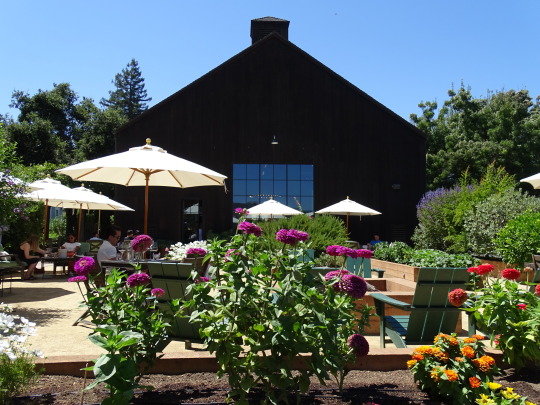
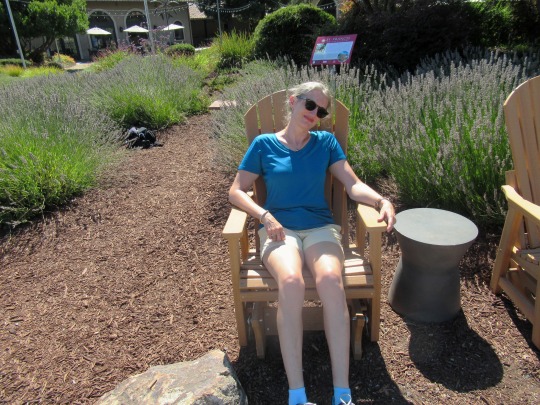
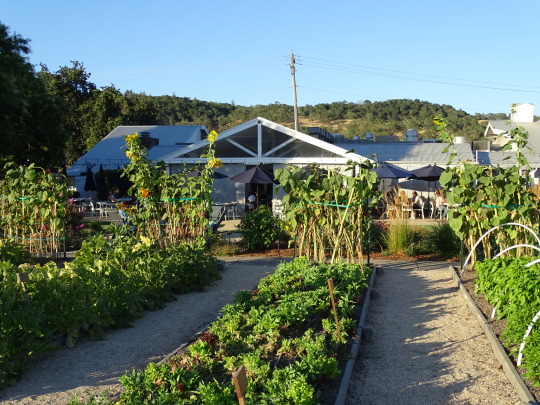
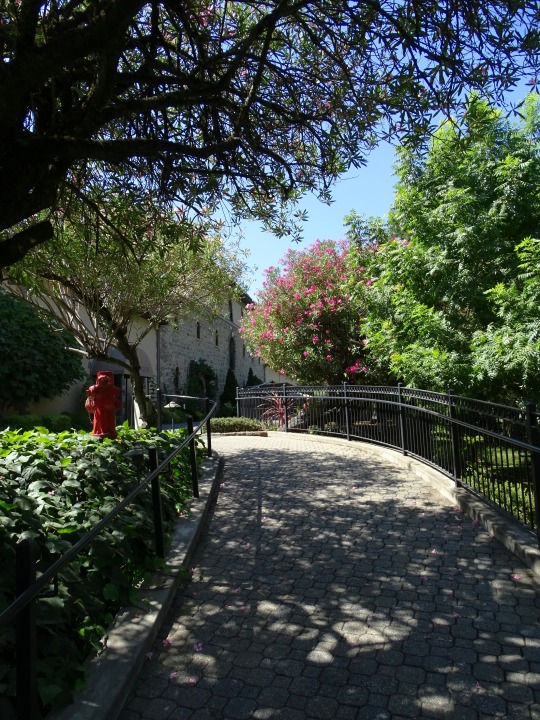
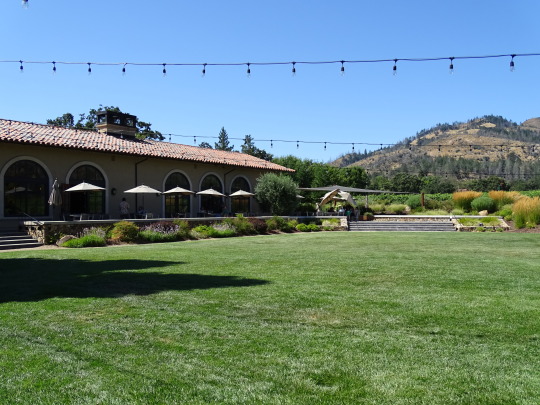
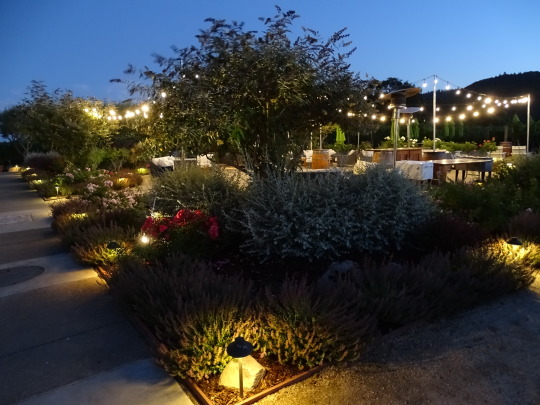



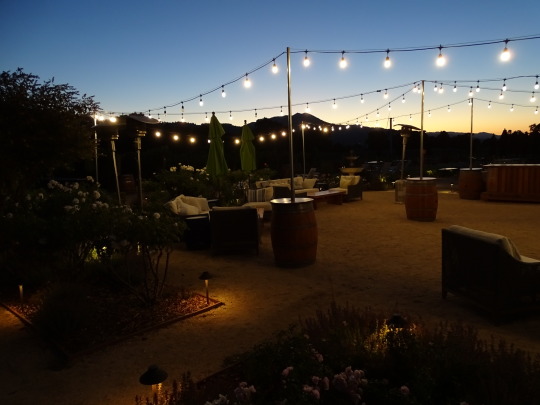

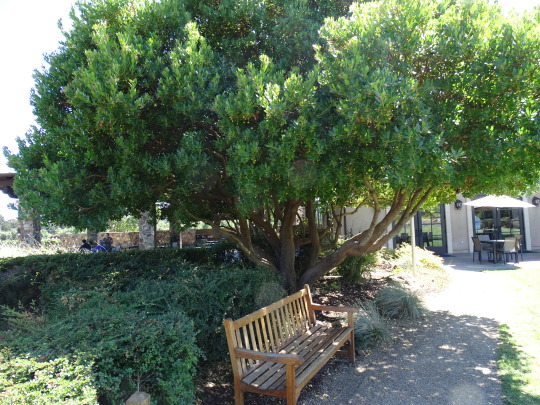
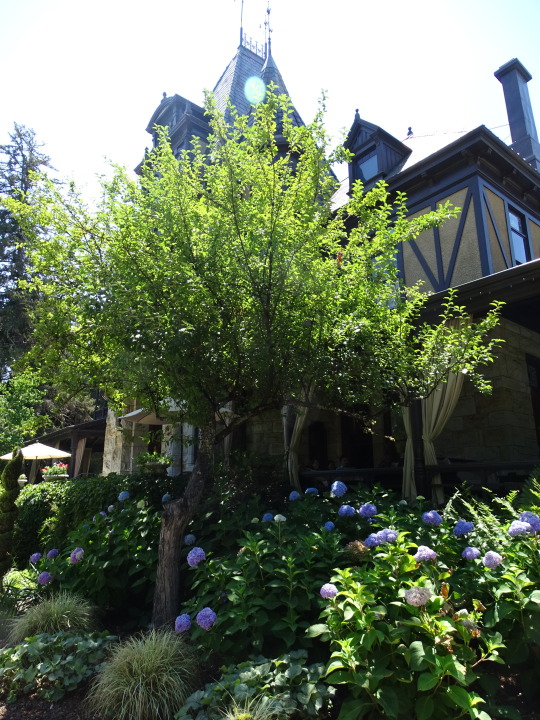
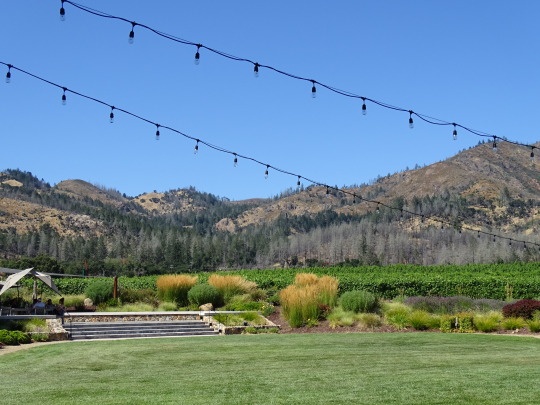
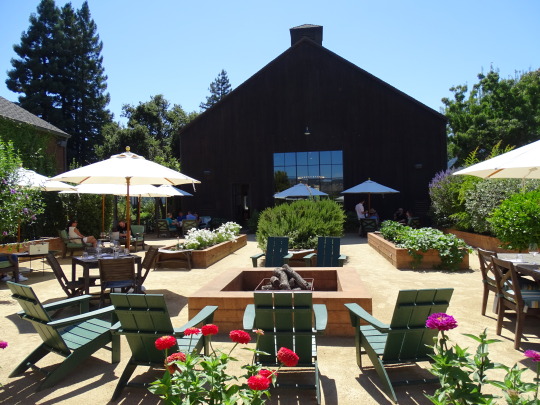
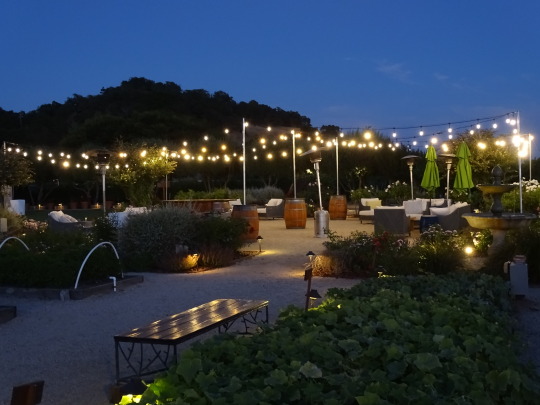
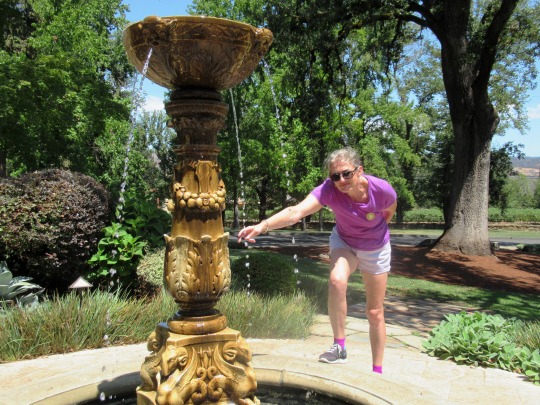
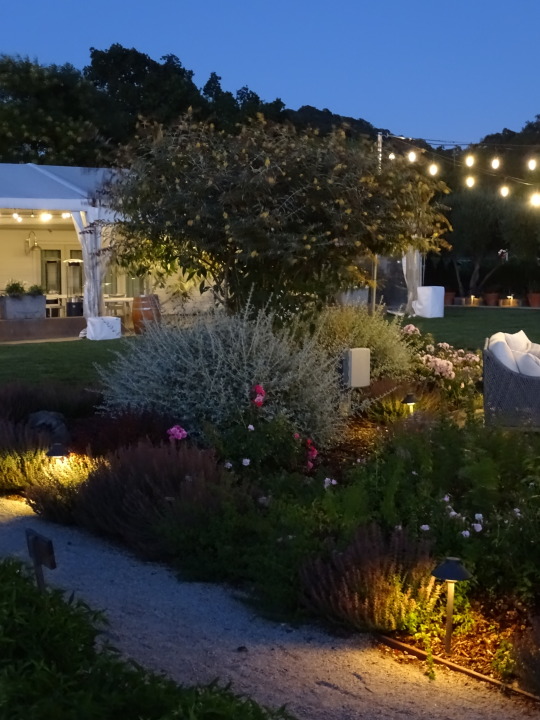
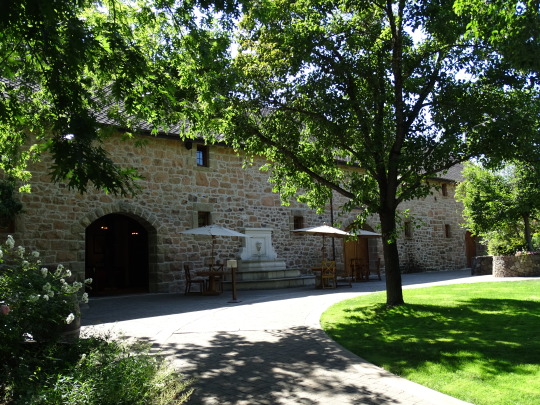
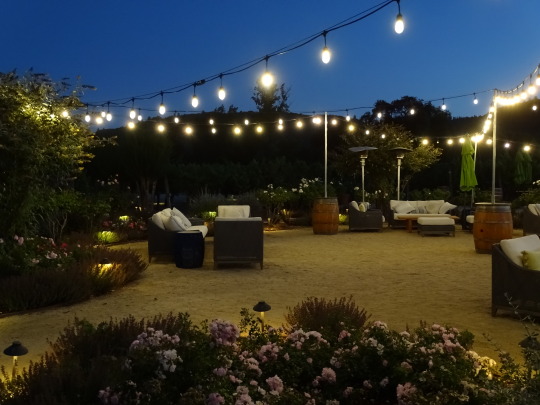
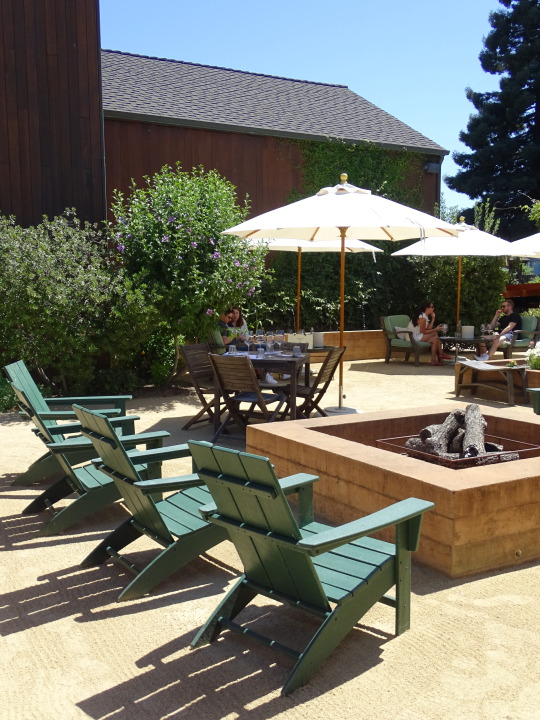

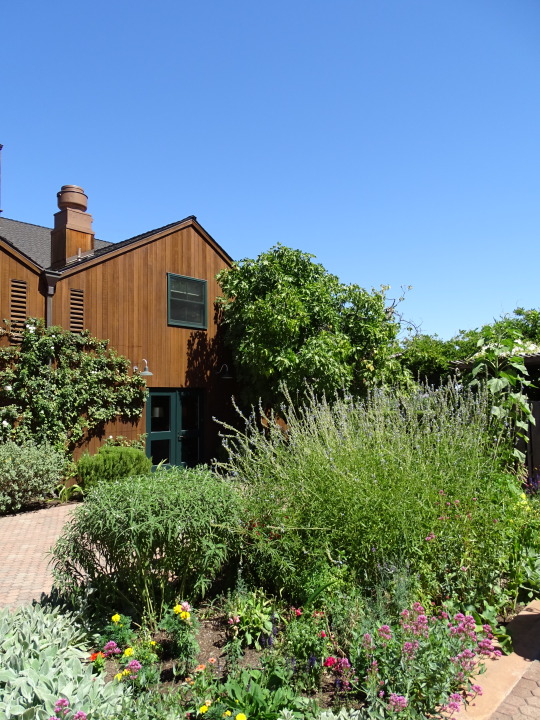
National Public Gardens Day
Get outside, get some fresh air, and literally stop and smell the roses by finding a public garden to stroll through and enjoy, by yourself or with those you love.
There are many different ways to define the word garden. Indeed, the term stretches to include everything from a small piece of land where flowers are grown to areas where we can plant fruit and veg. Similarly, gardens can be wide-open spaces that are filled with a large assortment of different plants. These public spaces are often the perfect spot to spend time with family and friends outside or enjoy some incredible entertainment. It’s not uncommon for public spaces to be used for outdoor theater and live music. These areas are known as public gardens.
Public gardens – the beautiful centerpieces to cities and large communities. Filled with different assortments of flora and fauna, they are the bright and colorful beacon in the middle of a large and dully-colored metropolis. They’re a reminder of the beauty that nature holds, a great place for picnics, and taking kids out for a play date. But where did the first public garden originate and when? Come with us as we delve into the past of National Public Gardens Day!
History of National Public Gardens Day
Mesopotamia, the “land between the rivers” Tigris and Euphrates, comprises a hilly and mountainous northern area and flat, alluvial south. Its peoples were urban and literate from about 3,000 BC.
Evidence for their gardens comes from written texts, pictorial sculpture, and archaeology. In western tradition, Mesopotamia was the location of the Garden of Eden and the Hanging Gardens of Babylon. Temple gardens developed from the representation of a sacred grove. Several distinct styles of the royal garden are also known.
The courtyard garden was enclosed by the walls of a palace. On a larger scale was a cultivated place inside the city walls. At Mari on the Middle Euphrates (c 1,800BC), one of the huge palace courtyards was called the Court of the Palms. It is crossed by raised walkways of baked brick; the king and his entourage would dine there.
At Ugarit (1,400BC) there was a stone water basin, not located centrally as in later Persian gardens, for the central feature was probably a tree (date palm or tamarisk). The 7th century BC Assyrian king Assurbanipal is shown on a sculpture feasting with his queen, reclining on a couch beneath an arbor of vines, and attended by musicians.
Trophies of conquest are on display, including the dismembered head of the king of Elam hanging from a fragrant pine branch! A Babylonian text from the same period is divided into sections as if showing beds of soil with the names of medicinal, vegetable, and herbal plants written into each square, perhaps representing a parterre design.
On a larger scale, royal hunting parks were established to hold the exotic animals and plants which the king had acquired on his foreign campaigns. King Tiglath Pileser I (1,000BC) lists horses, oxen, asses, deer, gazelle, and ibex, boasting “I numbered them like flocks of sheep.”
From around 1,000 BC the Assyrian kings developed a style of city gardening incorporating a naturalistic layout, running water supplied from river headwaters, and exotic plants from their foreign campaigns.
Assurnasirpal II (883-859BC) lists pines of different kinds, including cypresses, junipers, almonds, dates, ebony, rosewood, olive, oak, tamarisk, walnut, terebinth, ash, fir pomegranate, pear, quince, fig, and grapevines. “The canal water gushes from above into the gardens; fragrance pervades the walkways; streams of water as numerous as the stars of heaven flow in the pleasure garden…
Like a squirrel, I pick fruit in the garden of delights.” The city garden reached its zenith with the palace design of Sennacherib(704-681BC) whose water system stretched for 50 km into the hills. The garden was higher and more ornate than any other and he boasted of the complex technologies he deployed, calling his garden palace “a Wonder for all Peoples”.
While public gardens may have origins deep in the past, Public Garden Day is a fairly modern celebration. Celebrations began in 2009 and it was created as a way to both enjoy and celebrate these beautiful spaces. The day is also a time where there are campaigns to build awareness around these spaces and what they mean to the local community. As well as often being a prime location for public events, public gardens may also be an area for environmental conservation. As such, it’s common to find that on this day, there are campaigns to draw attention to this and ensure that both tourists and locals remember these locations.
Some people also view this day as the beginning of spring. This isn’t the official start of spring of course, but it does seem to be a time where more people go out and enjoy nature with their loved ones and people that they hold dear.
How to celebrate National Public Gardens Day
From roses to chrysanthemums, all we have to do is go outside to a public garden and admire the variety of flora. The beauty of nature is not one to take lightly. So, let’s get out there! Maybe we can even plant our own gardens to add some color to our homes.
The biblical Book of Genesis mentions the Tigris and Euphrates as two of the four rivers bounding the Garden of Eden. No specific place has been identified although there are many theories.
The Hanging Gardens of Babylon are listed by classical Greek writers as one of the Seven Wonders of The World. The excavated ruins of Babylon do not reveal any suitable evidence, which has led some scholars to suggest that they may have been purely legendary. Mesopotamia is believed to be the origin of the public garden and we’d have to say we don’t disagree.
Source
#National Public Gardens Day#NationalPublicGardensDay#second Friday of May#10 May 2024#original photography#Sonoma#Napa Valley#Brix Restaurant & Gardens#St. Helena#summer 2023#Beringer Vineyards#Freemark Abbey Winery#Louis M. Martini Winery#tourist attraction#landmark#countryside#flora#nature#California#West Coast#architecture#St. Francis Winery & Vineyards#USA#travel#vacation#landscape#cityscape#Turnbull Wine Cellars
1 note
·
View note
Text
Apply now: https://canadianjobbank.org/warehouse-worker-material-handling-35/
0 notes
Text
Petroglyphs in Jordan's Wadi Rum desert - are drawings or engravings made on rocks by the region's ancient inhabitants thousands of years ago.
source: bit.ly/3omjWSD
image: external to the representation indicators
Patina and colour of the design: can give information about the synchronicity between designs or superposition.
It is only recently that we became aware of the importance and the abundance of the petroglyphs heritage in Jordan, as new fields are now opened to investigations. While the Rock Art is already known and partly surveyed in the easy to access Wadi Rum, the Eastern Badia is newly explored by archaeologists who, aside to their researches on ancient settlements in the Harra, noticed uncountable petroglyphs. Out of the discoveries in those marginal areas as well as the undergoing surveys conducted in the South of Jordan, is emerging a huge heritage that was till now underestimated (below photo from author).
Middle East Rock Art outreaches borders of space and time. We speak about thousands and thousands of rock images and inscriptions stretching from Syria to Saudi Arabia, mainly through the basalt and sandstone areas. They attest to the presence and activities of nomadic and semi-nomadic peoples in those nowadays desert lands over a period estimated to 12 000 years, from the Neolithic (10 200 BC) till now, without interruption in certain areas like Wadi Rum. The Rock Art domain even extends far to East till beyond Iran. We are in front of a gigantic open-air library, that delivers information about environment, animals, humans, languages, scripts system, worships, historical events… beyond some local specificities and evolutions, the petroglyphs also put in light a common heritages and wide exchanges networks linking Middle East people throughout the ages.
Geographically, petroglyphs are not regularly spread through the domain. We generally find a higher density in connection with settlements, elevated places, hunting zones and water points. In the Eastern Desert, the till now recorded petroglyphs concentrations are mainly located in and around Jabal Qurma, Wisad pools, Wadi Qattafi and some spots in Ruwaished area.. In Wadi Rum however, the sites are more regularly spread, with a higher density at proximity of water sources.
Particularly prosperous in petroglyphs, Wadi Rum must be understood as part of a cultural zone extending to the North of Saudi Arabia, the Hisma desert that corresponds geologically to a low plateau starting on its northern side at the depression of Ras El Naqab and extending into Saudi Arabia. This area is the cradle of a culture of Arabic background called Hismaic, which developed a local specificities and script system derived from Thamudic.
The geographical extension of the petroglyphic domain does not lead to a relevant differentiation in the imagery typology. However, some figures are more present is certain areas, as for example, the kites in the Eastern Desert, the hands in the Hisma area. Cattle seem absent in the Hisma desert while in the Wisad pools, humans are rarely represented. Regarding the inscriptions however, the geographical distribution is more evident, with a prevalence of Thamudic and Hismaic scripts in the Hisma Basin and of Safaitic in the Eastern Desert, among other scripts… (below photos from author)
The Rock Art was practiced over all the periods and some specimen date to the 20th century, as this example of the electric pylon of the scene of the motorcycle accident, contingently interpreted as the fatal accident of Colonel Lawrence of Arabia (Wadi Rum, below images). Indeed, it would be erroneous to consider the petroglyphs as referring constantly to ancient periods.
Moreover, nowadays, the modern tourism is adding its touch with the testimonies of foreigner visitors letting their names, their drawing tentatives, honeymoon testimonials… (below photos from author)
Scholars estimate the oldest Wadi Rum petroglyphs to 10 000 BC, while it seems that those of the Eastern Badia, in correlation with the settlements, could be starting from 8 000 BC. It happens often a surface to have been used and reused over the time, cumulating by this way the representations over several periods. Petroglyphs dating is very challenging, as long as we cannot find indicators in the representations themselves. Themes are strangely constant over time, at least in pre- and historical periods, with only a variation of some executive features. The following table mention some elements that can contribute to the Rock Art dating. (below photos from author)
.br
Petróglifos no deserto de Wadi Rum, na Jordânia - são desenhos ou gravuras feitas em rochas pelos antigos habitantes da região há milhares de anos.
fonte: bit.ly/3omjWSD
imagem: externa aos indicadores de representação
Pátina e cor do desenho: pode dar informações sobre a sincronia entre desenhos ou sobreposição.
Só recentemente nos apercebemos da importância e da abundância do património dos petroglifos na Jordânia, abrindo-se agora novos campos à investigação. Enquanto a arte rupestre já é conhecida e parcialmente pesquisada no fácil acesso de Wadi Rum, a Badia Oriental é recentemente explorada por arqueólogos que, além de suas pesquisas sobre antigos assentamentos no Harra, notaram inúmeros petróglifos. Das descobertas naquelas zonas marginais bem como das sondagens em curso no sul da Jordânia, está a emergir um enorme património até agora subestimado (foto abaixo do autor).
A arte rupestre do Oriente Médio ultrapassa as fronteiras do espaço e do tempo. Falamos de milhares e milhares de imagens e inscrições rupestres que se estendem da Síria à Arábia Saudita, principalmente pelas áreas de basalto e arenito. Eles atestam a presença e atividades de povos nômades e seminômades naquelas terras hoje desérticas durante um período estimado em 12.000 anos, desde o Neolítico (10.200 aC) até agora, sem interrupção em certas áreas como Wadi Rum. O domínio da arte rupestre se estende até o leste até além do Irã. Estamos diante de uma gigantesca biblioteca a céu aberto, que veicula informações sobre meio ambiente, animais, humanos, línguas, sistema de escritas, cultos, eventos históricos… e amplas redes de intercâmbio que ligam os povos do Oriente Médio ao longo dos tempos.
Geograficamente, os petróglifos não estão regularmente espalhados pelo domínio. Geralmente encontramos uma densidade maior em relação a assentamentos, lugares elevados, zonas de caça e pontos de água. No Deserto Oriental, as concentrações de petroglifos até agora registradas estão localizadas principalmente em torno de Jabal Qurma, piscinas de Wisad, Wadi Qattafi e alguns pontos na área de Ruwaished. proximidade de fontes de água.
Particularmente próspero em petróglifos, Wadi Rum deve ser entendido como parte de uma zona cultural que se estende até o norte da Arábia Saudita, o deserto de Hisma que corresponde geologicamente a um planalto baixo que começa em seu lado norte na depressão de Ras El Naqab e se estende até a Arábia Saudita. Arábia. Esta área é o berço de uma cultura de origem árabe chamada hismaica, que desenvolveu especificidades locais e um sistema de escrita derivado do tamúdico.
A extensão geográfica do domínio petroglífico não conduz a uma diferenciação relevante na tipologia imagética. No entanto, algumas figuras estão mais presentes em determinadas áreas, como por exemplo, as pipas no Deserto Oriental, as mãos na zona de Hisma. O gado parece ausente no deserto de Hisma, enquanto nas piscinas de Wisad, os humanos raramente são representados. No que diz respeito às inscrições, no entanto, a distribuição geográfica é mais evidente, com prevalência de escritas tamúdicas e hismaicas na bacia de Hisma e de safaíticas no deserto oriental, entre outras escritas… (abaixo fotos do autor)
A Arte Rupestre foi praticada ao longo de todos os períodos e alguns exemplares datam do século XX, como este exemplo do poste elétrico do local do acidente de motocicleta, interpretado contingentemente como o acidente fatal do Coronel Lawrence da Arábia (Wadi Rum, abaixo imagens ). De fato, seria errôneo considerar que os petróglifos se referem constantemente a períodos antigos.
Além disso, hoje em dia, o turismo moderno está adicionando seu toque com os depoimentos de visitantes estrangeiros deixando seus nomes, suas tentativas de desenho, depoimentos de lua de mel… (abaixo fotos do autor)
Os estudiosos estimam que os petróglifos mais antigos de Wadi Rum datam de 10.000 aC, enquanto parece que os da Badia Oriental, em correlação com os assentamentos, podem começar em 8.000 aC. Acontece frequentemente uma superfície ter sido utilizada e reutilizada ao longo do tempo, acumulando assim as representações ao longo de vários períodos. A datação de petróglifos é muito desafiadora, desde que não possamos encontrar indicadores nas próprias representações. Os temas são estranhamente constantes ao longo do tempo, pelo menos em períodos pré e históricos, com apenas uma variação de algumas características executivas. A tabela a seguir menciona alguns elementos que podem contribuir para a datação da Arte Rupestre. (abaixo fotos do autor)

0 notes
Text
Everything You Should Know About Heliskiing!
Contact our Travel Designers to start out constructing your bespoke heli-skiing adventure. Or if you’re uncertain, inform us what you might be on the lookout for and problem us to encourage you. When you’re not skiing, delight in more snow-filled activities, from mountaineering and snowmobiling to snow kiting, canine sledding and speed boating in the Norwegian fjords. Craig has over 30 years expertise in the himals and 13 years experience skiing the Annapurna sanctuary. He values security above all else and is open to discussions about choices.
It consists of cover for medical and repatriation prices, journey cancellation and curtailment, plus it may possibly protect any misplaced, stolen, or broken ski tools while in your trip. I'm topic to my failing reminiscence, but IIRC the guides instructed that sensible common days (once you may have factored in all of the down time and so on...) might be ~15,000 feet vertical for heli vs ~10,000 for cat depending on the operation. First BC journey - Snow conditions have been good, but the climate was crap - no solar all week (but no down days, superb what kind of weather they will fly in!). Lodge was in an amazing distant location and very luxurious, but staying somewhere like that is not for me. It was actually costly, in all probability double the price of Alaska.
Tignes offers an enormous number of diversified terrain for skiers and boarders from difficult off-piste powder to leisurely cruising runs. What better method to hold the children entertained during the faculty holidays than activities on the mountain. If Heliskiing isn't your factor, then cat skiing might be your calling. Soho Basin is a personal ski space providing pristine high-country terrain, world class views and gourmet eating in an environment of relaxed and understated luxurious. These great chalets and skiing tips have been offered by Jacqui. For more on these skiing experiences, contact her and the Touch of Spice staff right here.
Take to the skies and experience the magic of this space for yourself alongside your friends and family. Find dynamic terrain in and round Minaret Alpine Station and lodge to suite any intermediate or skilled skiers and boarders, with pristine snow overlaying Heliskiing broad open bowls, pure half-pipes and chutes. Beautiful long runs will maximize your ski time and guides are there to direct you on to the best snow in the area.
The ski season is simply kicking off in New Zealand, one of many world’s premier snowsports locations. Read on for the most effective insider suggestions from our consultants at Majordomo and Touch of Spice. You don't need to book a complete week with a specialist tour operator not figuring out what the weather Heliskiing or snow conditions might be. You can merely make a day journey with a helicopter, Accompanied by an skilled mountain information, who will lead you thru Glaciers and Canyons for an unforgettable experience. There are numerous ski runs of varied levels of difficulty and lengths.
You don’t want to miss out on a day in the helicopter due to harm or a sore again. Being in good bodily health is paramount to essentially having fun with this trip and getting probably the most out of the expertise. On site scorching tubs and massages turn out to be an essential part of your aprés ski as opposed to beer and shots! If you're an off piste skiing enthusiast, enjoy heliskiing with esf Samoëns to discover unexplored places, on skis or snowboard. You can explore the hidden parts of the Aosta Valley, the Swiss Valais...
This is a particularly ‘useful’ drop as you can ski instantly again down to Täsch, just under Zermatt, and still have a good lunch on the Tascherhof Hotel. With the founding of AirZermatt in 1968, principally as an air ambulance and mountain rescue service, the possibilities for more leisure-orientated use of their gear turned apparent. UK-based ski mag with the best images and most knowledgeable Heliskiing but wittiest ski information within the English language. Departing from your local resort and adventuring additional afield to surrounding glaciers, resorts and national parks. The second selection is to ski directly from the highest of the”Glacier des Follats” then onto the “Glacier de Corbasssières”. At the tip of the glacier, you'll have a brief stroll before skiing right down to the lovely small village of Fionnay.
Whether or not it's off piste with the adults, a correct ski lesson for certainly one of us or taking the kids out for the afternoon you always get high power, great tips and a enjoyable time. Always a smile on his face, nothing is a problem only solutions! The whole household have hade the enjoyment to ski with Maxime from Pist to harsh off pist. Looking ahead to ski with him again within the Easter 2022. Book your freeride ski and snowboard lesson at the best assured price by contacting me.
0 notes
Text
Henry gpass fabric

Henry Glass Fabrics are high quality, quilt shop quality fabrics. It's just that I got really, well, I guess we're even.Henry Glass is one of our favorite fabric manufacturers! They have a host of famous designers, and add more every year! Some of the more well known designers and designers we carry include Kim Diehl, Jan Mott, Stacy West of Buttermilk Basin, Shelly Comisky of of Simply Shelly Designs, Leanne Anderson and her daughter Kaytlyn Kuebler, Janet Rae Nesbitt, Jane Shasky and many more! JACK: Well, thanks for helping me explain the origins of glass and sorry about throwing that water on you before. Nowadays we have all sorts of glass for all sorts of purposes, and it's opened up windows, so to speak, into a whole world of inventions and discoveries. He was the first to find a way of making glass perfectly flat. Well, most of that is thanks to this guy Henry Bessemer. Ah, not bad hey.Īnd in the 17th century we got telescopes.Īs for the big sheets of glass that are used in buildings pretty much everywhere. Then in the 16th century in Venice we got our first look at ourselves thanks to mirrors. Oh, I can see everything so much more clearly now. In the 13th century in Northern Italy the first glasses to enhance eye sight came about. Yeah, I love it, love what you've done.Īs the years went on glass became more and more popular. Oh, I'm just kidding, no, no it looks great. What have you done? All the glass is stained. By the 1100s many European cathedrals were being decorated with stained glass windows, coloured with powdered metals mixed into the molten glass. Instead, you might just have a hole in your wall with an animal hide curtain or a window made out of paper, fancy. Yep, there was a time when people didn't have glass windows. JACK: Manny, Manny, can you see me? I can see you. Glass blowing was later taken by the Romans who used it, along with a sort of pressing technique, to create the first glass windows. And around the first century BC the Syrians came up with the technique of glass blowing, which truly changed the game. Over the next few hundred or so years glass making became popular across the Mediterranean, Europe and into parts of Asia. Ha.Ībout 1000 years later the Ancient Egyptians also began creating things out of glass, in particular they were quite fond of making glass beads. But instead, no, I was making this, a cup for my drink. JACK: Yeah, so, all I did was mix silica sand, lime, and soda. And some historians reckon it might have happened by accident. But the first human efforts to make glass, that we know of anyway, happened around 2500 BC, in the ancient region known as Mesopotamia. Including Australia's First Nations peoples who used it as cutting tools, as tips for spears and for ceremonial purposes. And from what experts can tell humans have been using these types of glass for hundreds of thousands of years. There are a few other types of naturally occurring glass, like fulgurite which occurs when sand is hit by lightning and tektite which is the result of a meteorite impact. The other is typically, but not always, sand. What do you think?Īs the volcano would suggest, one of the main ingredients in making glass is heat. It appears to have been formed when the molten rock from this volcano cooled rapidly resulting in this sort of blackish/greenish thing. This is obsidian, it's a type of natural glass. While we clean up, let's take a look at the long, long history of glass and I do mean long. Bluebird of Happiness 2719-95 Mixed Media Dark Gray by Janet Rae Nesbitt for Henry Glass Fabrics. Oh gosh sorry, you're just so terrifying sometimes. Bluebird of Happiness 2715-95 Alphabet Dark Gray by Janet Rae Nesbitt for Henry Glass Fabrics. But have you ever wondered where does glass comes from? Why can I see through it? Is it just hot sand? And why can't I throw stones in glass houses? Well, I've asked a very dear friend of mine to help explain. JACK, REPORTER: When it comes to drinking vessels, for me, nothing beats a glass.

0 notes
Note
Hiya! I’ve been extremely interested in Cdrama’s as of late and the costumes! Now in some of these dramas there are dancing scenes. But I saw that not all the dancing scenes are done in chinese clothes. I saw one scene where they wore a ‘bedlah’. Can I get your input wether this is just modern aesethic or not. Thank you for your time in answering our asks!
Hi, thanks for the question!
I know what you’re referring to - in Chinese historical costume (guzhuang) dramas, you can occasionally see characters wearing bedlahs or bedlah-like outfits for dance scenes. Example below - a character wearing bedlah for a dance scene in historical Cdrama Myth of Sword (x):

Bedlahs typically show up as dance costumes in historical Cdramas for the following reasons:
To give the dance a seductive/sensual air (of course this can be achieved with Chinese clothing, but bedlahs add an additional element of mystery and/or “exoticness”)
To suggest/signify Xiyu influence. Xiyu (西域), lit. “Western Regions”, was a historical name specified in the Chinese chronicles between the 3rd century BC to the 8th century AD that referred to the regions west of Yumen Pass, most often Central Asia or sometimes more specifically the easternmost portion of it (e.g. Altishahr or the Tarim Basin in southern Xinjiang), though it was sometimes used more generally to refer to other regions to the west of China as well, such as the Indian subcontinent (as in the novel Journey to the West)
For example, Tang dynasty-set Cdrama Beauties in the Closet features a bedlah dance scene, in which animal spirits disguised as women perform a dance to seduce the emperor (x). The Tang dynasty is famous for its Silk Road trade route that enabled strong relations with the empires to its west (ex: Byzantine, Persian, Arabian). The Tang capital Chang'an became an international metropolis, and foreign clothing & hairstyles became trendy. In Chang’an and Luoyang, Turkish and Persian fashions were highly sought after (x). Thus, the bedlahs in this scene serve to emphasize the seductiveness of the dance, as well as make a nod to the multicultural nature of Tang society:
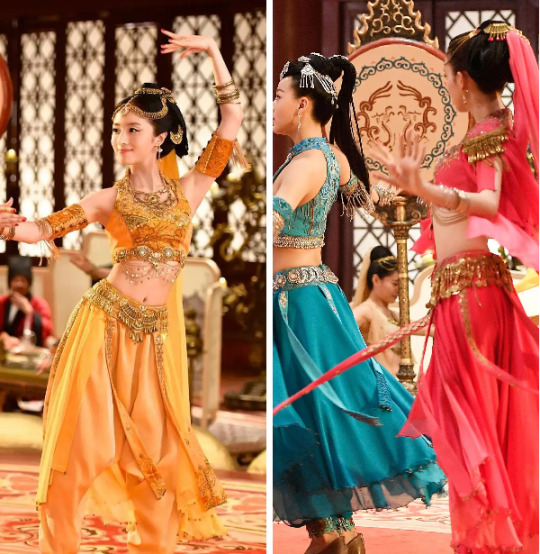
Another example comes from the historical Cdrama The Great Dunhuang, which is based on the history of the oasis city of Dunhuang, which lies on the ancient Silk Road. In this scene, Meiduo, a princess from the ancient Kingdom of Khotan, dances a feitian (apsara) dance in feitian costume (x). Feitian costumes as depicted in Chinese media have similarities with bedlah, as can be seen below:
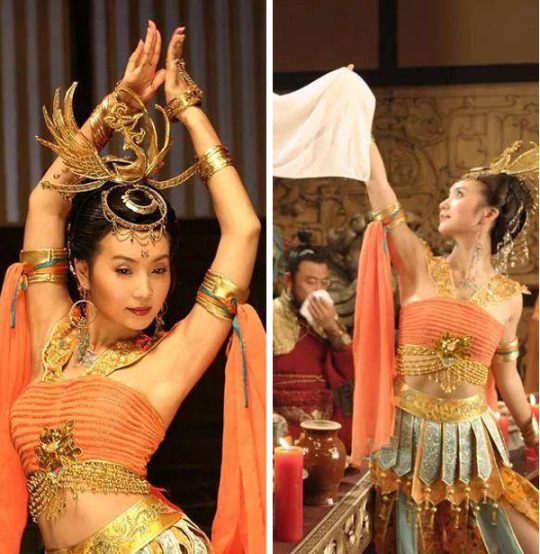
With all that said, though, the use of bedlahs in historical Cdrama costuming is still a modern aesthetic, due to the simple fact that the bedlah as we know it today is a modern 20th-century Egyptian belly dance costume influenced by European theatrical attire (1/2):
“The bedlah is essentially a Westernized creation, though not a wholly Western creation. What really cinched its iconic popularity in dance was the golden age of Egyptian Cinema in the 50s-70s, when Egyptian movies still largely cast professional dancers for dance roles. These Egyptian dancers, directors, and costumers sought inspiration from Hollywood and American culture - the bedlah is basically an Egyptianized iteration of the types of costuming that American dancers and showgirls were wearing. (Think Vegas, burlesque, cabaret, lounge and nightclub culture, in addition to movies/popular music culture.)” (Source)
Needless to say, this particular type of outfit did not even exist prior to the 1900s, much less during the Tang dynasty.
So why do they show up in historical Cdramas? As I’ve mentioned many times before (1/2/3), historical Chinese dramas tend to take a lot of liberties in their costume design. And indeed, this is one of those cases. I chalk it up to a combination of trying to appeal to modern audience’s aesthetics/expectations & lack of resources/attention. Researching & creating historically accurate outfits is a lot more difficult than slapping on a bedlah and calling it a day. ¯\_(ツ)_/¯
To be fair, this misunderstanding is a worldwide phenomenon, not just a Chinese one. For example, I don’t think it’s an exaggeration to say that Disney’s depiction of Princess Jasmine in a bedlah in Aladdin played a huge role in propagating the perception that the bedlah was an actual “ancient” historic outfit. This influence is especially noticeable in the recent Chinese “Xiyu aesthetic” fashion trend. Below are two Xiyu-style outfits with the theme “Loulan Princess” (the Loulan Kingdom was an ancient kingdom based around an important oasis city along the Silk Road) (x):


The “Princess Jasmine effect” is quite strong, wouldn’t you say? :P
For culturally/historically accurate Chinese dance clothes, please see my dance & dance hanfu tags.
If anyone wants to share more information, please do. Hope this helps!
362 notes
·
View notes
Note
After hearing bad news about my device (gotta buy a new keyboard for it bc without the keyboard I can't charge the damn stylus what is this stupid design choice— and I can't even find the keyboard being sold anywhere despite looking for basically half the day) and coming home extremely cranky, I'm going to dump my brain vomit on you 😭
Forgive me if these are incoherent because I also got my booster shot today and my head is hella cloudy.
Where I'm from, in our traditional wedding ceremonies, there's a part of it where the bride and groom link hands, and placed over a gold/silver/glass basin half-filled with water, and then a white cloth is wrapped around the joined hands and perfumed water is poured over it. I really like this idea so maybe it could be part of clan wedding traditions?
And heck, since the clan wedding involves planting a tree together, why not have them hold a seed in their joined and wrapped hands, and as they say their vows they'd have to channel magical energy into it, to mirror the way Araya's healer had unintentionally brought forth the Moon Tree.
Somewhere during the ceremony the couple fastens the bracelets on each other's wrists. This would have to take place before the whole wrapping situation, I'm realizing 🤣
The couple would be facing the Heart Tree, also probably facing north? That would be the clan's favored direction. But they could be facing towards each other before the time comes that they must say their vows.
And maybe there could be a part where all the wedding guests would take turns blessing the couple, maybe with a specific spell, maybe some would even come up with their own poem for the occasion.
I envisioned the couple sharing the same... what's the word— veil? blanket? I don't even know— on their heads and shoulders? I'm supposed to be a writer and I can't describe it 😭 I think that part would probably come after the vows are said. The ones to place that cloth over their heads would be their family members, maybe preferably older family members or mentors or such. (In Kazai and Shapur's wedding, that should've been Ayunnen and Kashi, had they lived) Sharing that shawl or veil or whatever could symbolize the couple sharing their burdens and comfort with each other as they face the adversities of life.
The couple walks together, their hands still linked with the cloth around it, in search of a place to plant the seed. The guests would sing as they follow and look for a good place too.
The clan head would be the one officiating the ceremony. The placing of the seed in the couple's hands, the wrapping, those would be done by the clan head and they could also initiate the process of vows, maybe asking questions kinda situation?
Weddings wouldn't be set on winter solstice and the week (or ten days) surrounding it.
Not sure what time of day weddings should take place: I've already placed both the solstice celebration and the coming-of-age ceremonies at night but hmm... Dusk? Dawn?
In any case though, magic would be involved.
The planting of the seedling would be the closing act of the ceremony. I can't figure out what comes after. Oh oh oh the couple can decide beforehand what species of tree they want to plant.
And then there's the little things about Zoroastrian wedding customs that I found:
“During the service married female relatives hold a fine scarf (nowadays usually white) over the couple's heads. At the same time two crystallized sugar cones are rubbed together, to sweeten the couple's life.
Then two parts of the scarf are sewn together with needle and thread to symbolize the uniting of the couple for the rest of their lives.
Traditionally, both bride and the bridegroom dress in white. The colour white is a symbol of purity in Zoroastrianism.”
×
“During the service female relatives of the couple (mainly the bride) hold over the couple’s head a fine scarf or other delicate fabrics like silk. Till 19th century this was green, Zoroastrians favorite color, now other colors particularly white are used as well.”
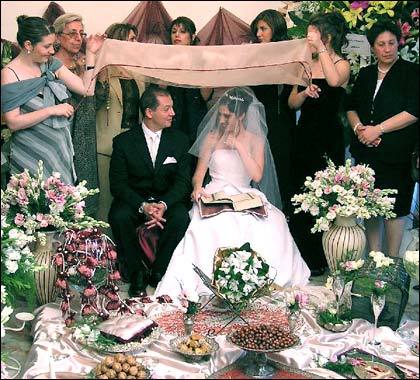

“During the ceremony rice is often used as a good luck symbol, with the bride and groom sprinkling each other with cupfuls of rice. So as to remove any evil destined for the groom an egg is passed round his head three times then thrown to the ground and broken, destroying the evil with it. A similar ritual is then performed with a coconut, and then with a small tray of water which is thrown to the ground.”
×
“Two different actions take place at the same time. Two pieces of crystallized sugar (shaped like cones) are rubbed together, a symbolic act to sweeten the couple’s life together. In the second act two parts of the same fabric are symbolically sewn together with needle and thread. The ceremony is suggestive of the ancient traditions when the bride and groom’s ceremonial belts (koshti) were tied and sewn together. Zoroastrians today hold over the grooms head a tray on which two pieces of cloth are united together, with needle, thread, scissors, a raw egg, a pomegranate or apple, dried marjoram, and white sweetmeats, all covered by a green kerchief. Koshti are ceremonial belts that are given to all Zoroastrians to mark the passage from childhood to adulthood. This is a rite of passage and is a very significant ritual in their lives. The symbolic act of sewing the bride and groom’s koshti together is uniting the couple for the rest of their lives, a knot is tied that should not be broken or separated.”
×
“At a point during the evening the groom will dip his hand into a water-pot (var-behendoo) which was part of the dowry. Into this pot he drops a silver coin, as a mark of appreciation for the gift.”
I forgot to copy the texts but the groom is placed on the right-hand-side of the bride because the right side is considered a direction/position of respect. I read once that Zoroastrian weddings take place at dusk? I might be remembering wrong. Oh and also they face east.
So for Shapur and Kazai's wedding... I have a few rough ideas on mish-mashing certain aspects of both traditions. For example the cloth being held above the couple's head, could later on be the same cloth the couple has to share as they search to plant a tree. The thing with the silver coin, but instead of a pot it goes into the basin in which they'll have to place their joined hands in. And of course sugar is involved.
I feel like it still needs a whole lot more fleshing out and polishing, but right now my head is really foggy and I'm just gonna go take a nap 😭
Ooh there are so many good ideas in here (I only really skimmed the articles on Zoroastrian marriage customs before). The integration of the the joined/wrapped hands sounds great, especially linking it to the clan's own mythology/origin! And the tree seed, and that they get to choose themselves which type of tree they're going to plant! That's a lovely addition, the growing of something new to mark the start of their life together.
I kind of feel like, if you're aiming to pick a specific time of day for clan weddings to take place, dawn seems a good option? Both because you already have other events taking place at night, and because dawn signifies beginnings, as in the start of their joined lives after the wedding ceremony, I guess? Perhaps some kind of pre-wedding tradition could happen at dusk before the day of the wedding itself, if you like that idea.
Are you going to have Shapur and Kazai dress in white? Is that the norm for clan weddings? It's funny that the article mentioned green as a previously-favoured colour (for the scarf) because I always thought Shapur would look good in dark green. (In yet another fic that I never actually wrote, I was going to have him dress in it for a formal occasion.)
I'm sorry there was more bad news about your device, that really sucks. I hope you've managed to find the right keyboard for it by now!
#wolfpack au#sorry i took so long to get to this ask!#i want to know everything about their wedding asdfhnghjg
33 notes
·
View notes
Photo






Palace of Aigai: The Biggest Building of Ancient Greece
The palace of Aigai, known today as Vergina, is considered not only the biggest but, together with the Parthenon, the most significant building of classical Greece.
Constructed during the reign of Philip II (359 – 336 BC) on a raised outcrop in Vergina in northern Greece, the palace, a remarkable landmark and symbol of power and beauty three times the size of the Parthenon, was visible from the whole Macedonian basin.
Archaeological evidence proves that the site was continuously inhabited starting from the Early Bronze Age (3rd Millenium BC) while in the Early Iron Age (11th to 8th centuries BC), it became an important rich and densely populated center.
The city reached its zenith in the Archaic (7th – 6th centuries BC) and Classical periods (5th-4th centuries), when it was the most important urban center of the area, the seat of the Macedonian kings, and the site for the establishment of many traditional sanctuaries.
The palace of Aigai was designed for Philip by an ingenious architect, most likely Pytheos, known for his contribution to the construction of the Mausoleum at Halicarnassus and to the development of urban planning and the theory of proportion.
Aigai Palace was covered with high-quality marble stucco
The east wing of the Aigai Palace included a monumental entrance, the ‘Tholos’ (probably a place of worship), and other rooms of unknown purpose.
The south wing contained the residential rooms proper as well as banqueting halls decorated with mosaic floors. Banqueting halls were located in the west wing.
On the lower north slope, there extended a long and narrow veranda in front of the chambers.
The masonry and architectural members were covered with lustrous, high-quality marble stucco that resembles marble.
Thousands of roofing tiles and relief antefixes of excellent quality, hundreds of square meters of floors covered with marble inlays and mosaics, some of which constitute exceptional works of art, extravagant pigments, bronze, and all kinds of luxurious materials were utilized in the creation of a complex that would fulfill the king’s ambitions.
Basic elements of the structure include: the large square peristyle (row of columns surrounding a space within a building) which comprises the heart of the building; the surrounding areas with their impressive propylon (the structure forming the entrance to a building); and the stoes (porticos, roofed colonnades) which form the façade and by which the propylon is enclosed. These constitute the foundational elements of this contemporarily innovative architectural project.
Royal tombs at Aigai include King Philip II
The most important remains at Aigai are the monumental palace and burial ground with more than 300 tumuli, some of which date to the 11th century B.C..
Greek archaeologist Manolis Andronikos brought to light the royal tombs in the Great Tumulus of Vergina (Megale Toumba) in 1977.
The most remarkable of these was the tomb of Philip II (359-336 B.C.). Its discovery is considered to be one of the most important archaeological events of the century.
Since 1977, continuing excavations have revealed a series of significant monuments.
This priceless archaeological site and the treasures discovered there were included on the list of UNESCO World Heritage Sites in 1996.
By Tasos Kokkinidis.
#Palace of Aigai: The Biggest Building of Ancient Greece#archeology#archeolgst#architecture#ancient architecture#history#history news#ancient history#ancient culture#ancient civilizations#ancient greece#greek history
49 notes
·
View notes
Photo
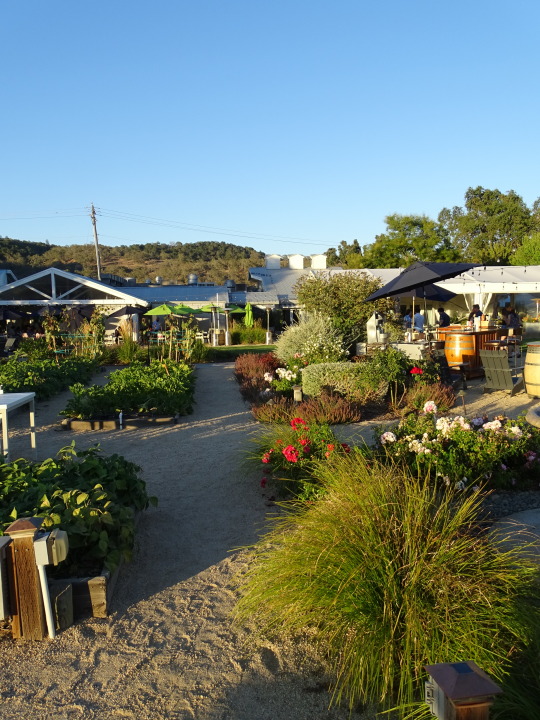
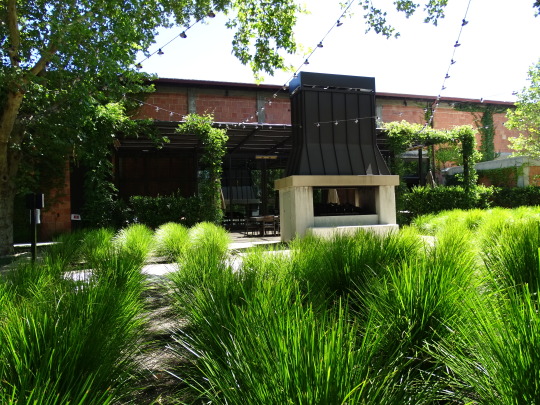
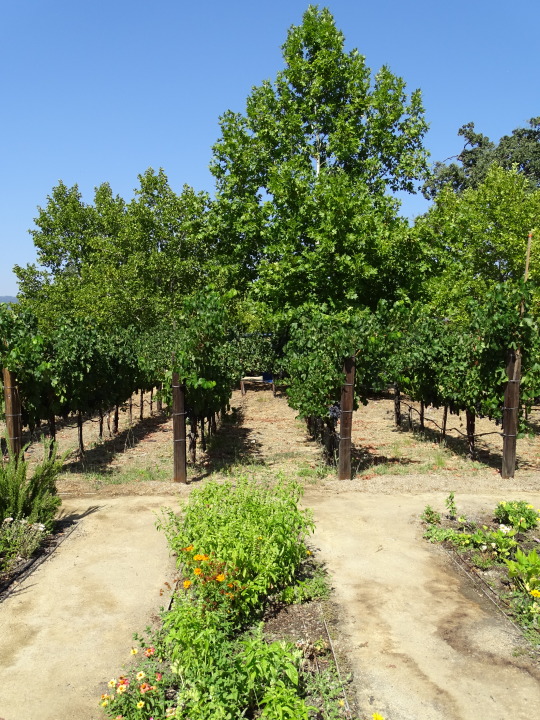
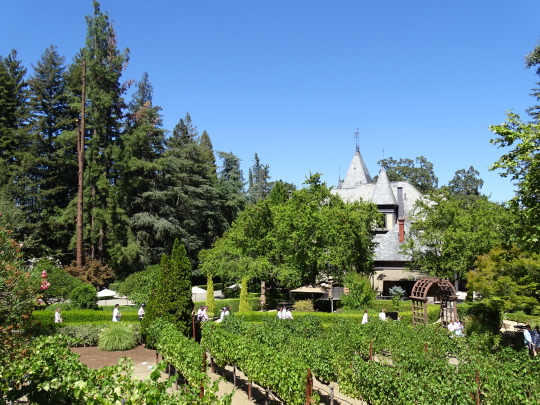

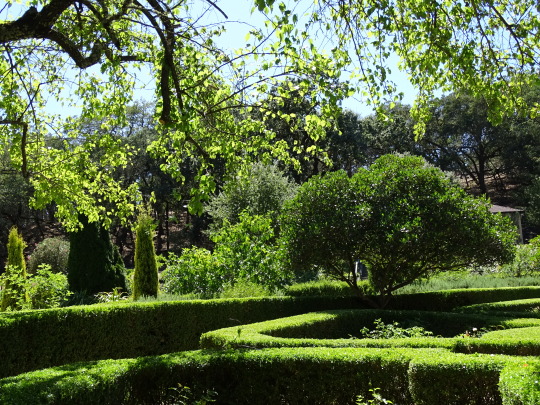

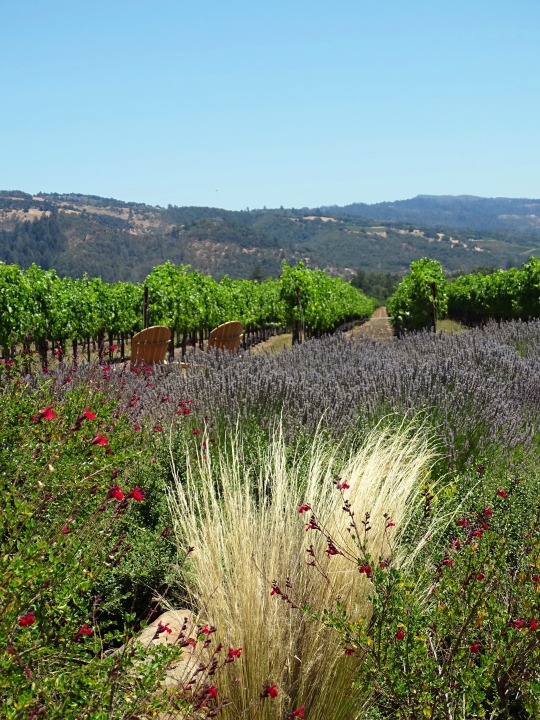
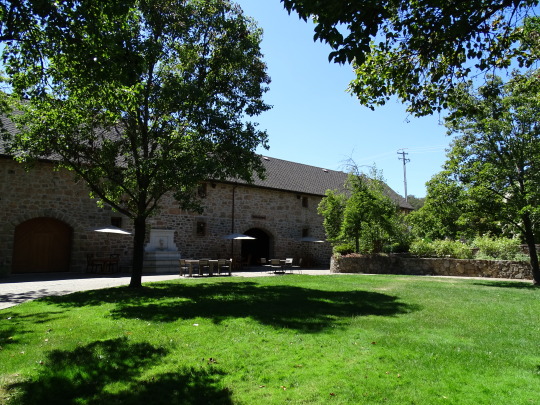
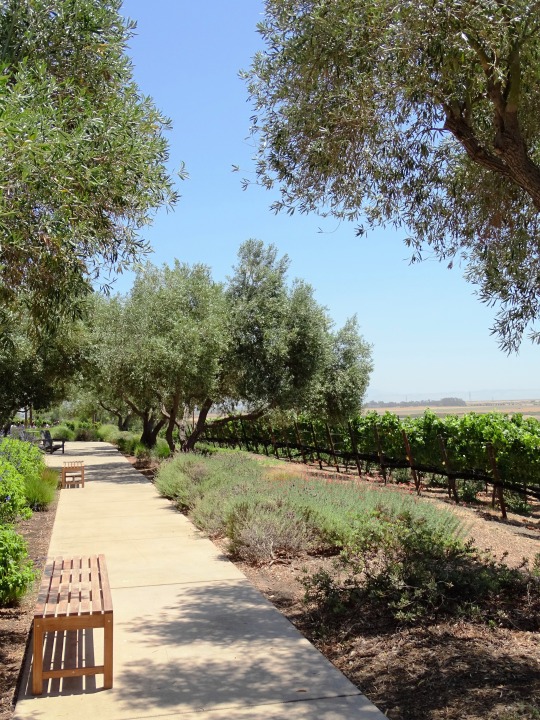
National Public Gardens Day
Get outside, get some fresh air, and literally stop and smell the roses by finding a public garden to stroll through and enjoy, by yourself or with those you love.
There are many different ways to define the word garden. Indeed, the term stretches to include everything from a small piece of land where flowers are grown to areas where we can plant fruit and veg. Similarly, gardens can be wide-open spaces that are filled with a large assortment of different plants. These public spaces are often the perfect spot to spend time with family and friends outside or enjoy some incredible entertainment. It’s not uncommon for public spaces to be used for outdoor theater and live music. These areas are known as public gardens.
Public gardens – the beautiful centerpieces to cities and large communities. Filled with different assortments of flora and fauna, they are the bright and colorful beacon in the middle of a large and dully-colored metropolis. They’re a reminder of the beauty that nature holds, a great place for picnics, and taking kids out for a play date. But where did the first public garden originate and when? Come with us as we delve into the past of National Public Gardens Day!
History of National Public Gardens Day
Mesopotamia, the “land between the rivers” Tigris and Euphrates, comprises a hilly and mountainous northern area and flat, alluvial south. Its peoples were urban and literate from about 3,000 BC.
Evidence for their gardens comes from written texts, pictorial sculpture, and archaeology. In western tradition, Mesopotamia was the location of the Garden of Eden and the Hanging Gardens of Babylon. Temple gardens developed from the representation of a sacred grove. Several distinct styles of the royal garden are also known.
The courtyard garden was enclosed by the walls of a palace. On a larger scale was a cultivated place inside the city walls. At Mari on the Middle Euphrates (c 1,800BC), one of the huge palace courtyards was called the Court of the Palms. It is crossed by raised walkways of baked brick; the king and his entourage would dine there.
At Ugarit (1,400BC) there was a stone water basin, not located centrally as in later Persian gardens, for the central feature was probably a tree (date palm or tamarisk). The 7th century BC Assyrian king Assurbanipal is shown on a sculpture feasting with his queen, reclining on a couch beneath an arbor of vines, and attended by musicians.
Trophies of conquest are on display, including the dismembered head of the king of Elam hanging from a fragrant pine branch! A Babylonian text from the same period is divided into sections as if showing beds of soil with the names of medicinal, vegetable, and herbal plants written into each square, perhaps representing a parterre design.
On a larger scale, royal hunting parks were established to hold the exotic animals and plants which the king had acquired on his foreign campaigns. King Tiglath Pileser I (1,000BC) lists horses, oxen, asses, deer, gazelle, and ibex, boasting “I numbered them like flocks of sheep.”
From around 1,000 BC the Assyrian kings developed a style of city gardening incorporating a naturalistic layout, running water supplied from river headwaters, and exotic plants from their foreign campaigns.
Assurnasirpal II (883-859BC) lists pines of different kinds, including cypresses, junipers, almonds, dates, ebony, rosewood, olive, oak, tamarisk, walnut, terebinth, ash, fir pomegranate, pear, quince, fig, and grapevines. “The canal water gushes from above into the gardens; fragrance pervades the walkways; streams of water as numerous as the stars of heaven flow in the pleasure garden…
Like a squirrel, I pick fruit in the garden of delights.” The city garden reached its zenith with the palace design of Sennacherib(704-681BC) whose water system stretched for 50 km into the hills. The garden was higher and more ornate than any other and he boasted of the complex technologies he deployed, calling his garden palace “a Wonder for all Peoples”.
While public gardens may have origins deep in the past, Public Garden Day is a fairly modern celebration. Celebrations began in 2009 and it was created as a way to both enjoy and celebrate these beautiful spaces. The day is also a time where there are campaigns to build awareness around these spaces and what they mean to the local community. As well as often being a prime location for public events, public gardens may also be an area for environmental conservation. As such, it’s common to find that on this day, there are campaigns to draw attention to this and ensure that both tourists and locals remember these locations.
Some people also view this day as the beginning of spring. This isn’t the official start of spring of course, but it does seem to be a time where more people go out and enjoy nature with their loved ones and people that they hold dear.
How to celebrate National Public Gardens Day
From roses to chrysanthemums, all we have to do is go outside to a public garden and admire the variety of flora. The beauty of nature is not one to take lightly. So, let’s get out there! Maybe we can even plant our own gardens to add some color to our homes.
The biblical Book of Genesis mentions the Tigris and Euphrates as two of the four rivers bounding the Garden of Eden. No specific place has been identified although there are many theories.
The Hanging Gardens of Babylon are listed by classical Greek writers as one of the Seven Wonders of The World. The excavated ruins of Babylon do not reveal any suitable evidence, which has led some scholars to suggest that they may have been purely legendary. Mesopotamia is believed to be the origin of the public garden and we’d have to say we don’t disagree.
Source
#National Public Gardens Day#NationalPublicGardensDay#second Friday of May#12 May 2023#original photography#Ram's Gate Winery#Cline Family Cellars#Sonoma#Napa Valley#Brix Restaurant & Gardens#St. Helena#summer 2022#Beringer Vineyards#Hall Winery#Freemark Abbey Winery#Louis M. Martini Winery#tourist attraction#landmark#countryside#flora#nature#California#West Coast#architecture
1 note
·
View note